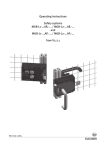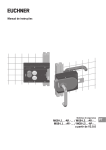Download Operating Instructions CES-I-AP-.-C04
Transcript
Operating Instructions Non-Contact Safety Switch CES-I-AP-.-C04-… (Unicode/Multicode) EN Operating Instructions Non-Contact Safety Switch CES-I-AP-.-C04-… Contents 1. About this document.............................................................................................. 4 1.1.Scope.............................................................................................................................................4 1.2. Target group...................................................................................................................................4 1.3. Key to symbols................................................................................................................................4 1.4. Supplementary documents...............................................................................................................4 2. Correct use........................................................................................................... 5 3. Description of the safety function........................................................................... 6 4. Exclusion of liability and warranty.......................................................................... 6 5. General safety instructions.................................................................................... 6 6.Function................................................................................................................ 7 6.1. Door monitoring output....................................................................................................................7 6.2. Diagnostics output...........................................................................................................................7 6.3. Limit-range monitoring.....................................................................................................................7 6.4. Switching states..............................................................................................................................7 7.Mounting............................................................................................................... 8 8. Electrical connection............................................................................................. 9 8.1. Notes about ..........................................................................................................................10 8.2. Safety in case of faults...................................................................................................................10 8.3. Fuse protection for power supply....................................................................................................10 8.4. Requirements for connection cables................................................................................................10 8.5. Connector assignment of safety switch CES‑I‑AP‑.‑C04......................................................................11 8.6.Connection....................................................................................................................................12 8.7. Notes on operation with safe control systems..................................................................................13 8.8. Devices for direct connection to IP65 field modules.........................................................................13 9.Setup.................................................................................................................. 14 9.1. LED indicators...............................................................................................................................14 9.2. Teach-in function for actuator (only for unicode evaluation)................................................................14 9.2.1. Preparing device for the teach-in operation and teaching in actuator.....................................14 Functional check............................................................................................................................15 9.3.1. Electrical function test.......................................................................................................15 9.3. 10. 2 System status table CES-I-AP-…........................................................................... 16 (translation of the original operating instructions) 115159-06-04/15 Operating Instructions Non-Contact Safety Switch CES-I-AP-.-C04-… 11. Technical data..................................................................................................... 17 11.1. 11.2. 11.3. Technical data of safety switch CES‑I‑AP‑.‑C04‑….............................................................................17 11.1.1. Typical system times.........................................................................................................18 11.1.2. Dimension drawing of safety switch CES‑I‑AP‑C04-…............................................................19 Technical data of actuator CES-A-BBN-C04.......................................................................................20 11.2.1. Dimension drawing............................................................................................................20 11.2.2. Operating distances..........................................................................................................20 11.2.3. Typical operating distance in approach direction A...............................................................21 Technical data of actuator CES-A-BDN-06.........................................................................................22 11.3.1. Dimension drawing............................................................................................................22 11.3.2. Operating distances..........................................................................................................22 12. Ordering information and accessories.................................................................. 23 13. Inspection and service......................................................................................... 23 14.Service............................................................................................................... 23 15. Declaration of conformity.................................................................................... 24 EN 115159-06-04/15 (translation of the original operating instructions) 3 Operating Instructions Non-Contact Safety Switch CES-I-AP-.-C04-… 1. About this document 1.1. Scope These operating instructions are valid for all CES-I-AP-.-C04-…. These operating instructions, the document “Safety information and maintenance” and any enclosed data sheet form the complete user information for your device. 1.2. Target group Design engineers and installation planners for safety devices on machines, as well as setup and servicing staff possessing special expertise in handling safety components. 1.3. Key to symbols Symbol/depiction Significance Printed document www t ne er Int Document is available for download at www.euchner.de Document on CD DANGER WARNING CAUTION NOTICE Important! Tip Safety precautions Danger of death or severe injuries Warning about possible injuries Caution minor injuries possible Notice about possible device damage Important information Tip/useful information 1.4. Supplementary documents The overall documentation for this device consists of the following documents: Document title (document number) Contents Safety information and maintenance CES‑I‑AP (091181) Basic information on safe setup and service Operating instructions (115159) (this document) Possibly enclosed data sheet Item-specific information about deviations or additions Important! Always read all documents to gain a complete overview of safe installation, setup and use of the device. The documents can be downloaded from www.euchner.de. For this purpose enter the doc. no. in the search box. 4 (translation of the original operating instructions) 115159-06-04/15 Operating Instructions Non-Contact Safety Switch CES-I-AP-.-C04-… 2. Correct use Safety switches series CES‑I‑AP are interlocking devices without guard locking (type 4). The device complies with the requirements according to EN IEC 60947-5-3. Devices with unicode evaluation possess a high coding level; devices with multicode evaluation feature a low coding level. In combination with a movable safety guard and the machine control, this safety component prevents dangerous machine functions from occurring while the safety guard is open. A stop command is triggered if the safety guard is opened during the dangerous machine function. This means: ÌÌStarting commands that cause a dangerous machine function must become active only when the safety guard is closed. ÌÌOpening the safety guard triggers a stop command. ÌÌClosing a safety guard must not cause automatic starting of a dangerous machine function. A separate start command must be issued. For exceptions, refer to EN ISO 12100 or relevant C‑standards. Before the device is used, a risk assessment must be performed on the machine, e.g. in accordance with the following standards: ÌÌEN ISO 13849‑1, Safety of machinery – Safety-related parts of control systems – Part 1: General principles for design ÌÌEN ISO 12100, Safety of machinery – General principles for design – Risk assessment and risk reduction ÌÌIEC 62061, Safety of machinery – Functional safety of safety-related electrical, electronic and programmable electronic control systems Correct use includes observing the relevant requirements for installation and operation, particularly based on the following standards: ÌÌEN ISO 13849‑1, Safety of machinery – Safety-related parts of control systems – Part 1: General principles for design ÌÌEN ISO 14119 (supersedes EN 1088), Safety of machinery – Interlocking devices associated with guards – Principles for design and selection ÌÌEN 60204‑1, Safety of machinery – Electrical equipment of machines – Part 1: General requirements The safety switch is only allowed to be operated in conjunction with the intended CES actuators from EUCHNER and the related connection components from EUCHNER. On the use of different actuators or other connection components, EUCHNER provides no warranty for safe function. Important! ÌÌThe user is responsible for the proper integration of the device into a safe overall system. For this purpose, the overall system must be validated, e.g. in accordance with EN ISO 13849‑2. ÌÌIt is only allowed to use components that are permissible in accordance with the table below. Table 1: Possible combinations for CES components Actuator Safety switch CES-A-BBN-C04-115271 CES-A-BDN-06-104730 CES-I-AP-.-C04-... EN Key to symbols Combination possible 115159-06-04/15 (translation of the original operating instructions) 5 Operating Instructions Non-Contact Safety Switch CES-I-AP-.-C04-… 3. Description of the safety function Devices from this series feature the following safety functions: Monitoring of the safety guard position (interlocking device according to EN ISO 14119) ÌÌSafety function: -- The safety outputs are switched off when the safety guard is open (see chapter 6.4. Switching states on page 7). ÌÌSafety characteristics: category, Performance Level, PFHd (see chapter 11. Technical data on page 17). 4. Exclusion of liability and warranty In case of failure to comply with the conditions for correct use stated above, or if the safety instructions are not followed, or if any servicing is not performed as required, liability will be excluded and the warranty void. 5. General safety instructions Safety switches fulfill personal protection functions. Incorrect installation or tampering can lead to fatal injuries to personnel. Check the safe function of the safety guard particularly ÌÌafter any setup work ÌÌafter the replacement of a system component ÌÌafter an extended period without use ÌÌafter every fault Independent of these checks, the safe function of the safety guard should be checked at suitable intervals as part of the maintenance schedule. WARNING Danger to life due to improper installation or due to bypassing (tampering). Safety components perform a personal protection function. ÌÌSafety components must not be bypassed, turned away, removed or otherwise rendered ineffective. On this topic pay attention in particular to the measures for reducing the possibility of bypassing according to EN ISO 14119:2013, section 7. ÌÌThe switching operation must be triggered only by actuators designated for this purpose. ÌÌPrevent bypassing by means of replacement actuators (only for multicode evaluation). For this purpose, restrict access to actuators and to keys for releases, for example. ÌÌMounting, electrical connection and setup only by authorized personnel possessing the following knowledge: -- specialist knowledge in handling safety components -- knowledge about the applicable EMC regulations -- knowledge about the applicable regulations on occupational safety and accident prevention. Important! Prior to use, read the operating instructions and keep these in a safe place. Ensure the operating instructions are always available during mounting, setup and servicing. EUCHNER cannot provide any warranty in relation to the readability of the CD for the storage period required. For this reason you should archive a printed copy of the operating instructions. You can download the operating instructions from www.euchner.de. 6 (translation of the original operating instructions) 115159-06-04/15 Operating Instructions Non-Contact Safety Switch CES-I-AP-.-C04-… 6. Function The safety switch monitors the position of movable safety guards. The safety outputs are switched on/off when the actuator moves into/out of the operating distance. The system consists of the following components: coded actuator (transponder) and switch. Whether the complete actuator code of the device is taught in (unicode) or not (multicode) depends on the respective version. ÌÌDevices with unicode evaluation: The actuator must be assigned to the safety switch by a teach-in operation so that it is detected by the system. This unambiguous assignment ensures a particularly high level of protection against tampering. The system thereby possesses a high coding level. ÌÌDevices with multicode evaluation: Unlike systems with unique code detection, on multicode devices a specific code is not polled but instead it is only checked whether the actuator is of a type that can be detected by the system (multicode detection). There is no exact comparison of the actuator code with the taught-in code in the safety switch (unique code detection). The system possesses a low coding level. When the safety guard is closed, the actuator is moved towards the safety switch. When the switch-on distance is reached, power is supplied to the actuator via the switch and data transfer takes place. If a permissible code is detected, the safety outputs are switched on. The safety outputs are switched off when the safety guard is opened. In the event of a fault in the safety switch, the safety outputs are switched off and the DIA LED illuminates red. The occurrence of faults is detected at the latest on the next demand to close the safety outputs (e.g. on starting). 6.1. Door monitoring output The door monitoring output is switched on as soon as a valid actuator is detected in the operating distance. 6.2. Diagnostics output The diagnostics output is switched on in the event of a fault (switch-on condition as for DIA LED). 6.3. Limit-range monitoring If the safety door with the actuator should settle over time, the actuator can drift out of the read head operating distance. The device recognizes this situation and indicates that the actuator is in the limit range by flashing the STATE LED. This allows the safety door to be readjusted in time. Also see chapter 10. System status table CES-I-AP-… on page 16. 6.4. Switching states The detailed switching states for your switch can be found in the system status table. All safety outputs, monitoring outputs and indicating LEDs are described there. Safety guard closed (actuator in operating distance and permissible coding detected) Safety guard open (actuator not in operating distance) Safety outputs FO1A and FO1B on off Monitoring output OD on off 115159-06-04/15 (translation of the original operating instructions) EN 7 Operating Instructions Non-Contact Safety Switch CES-I-AP-.-C04-… 7. Mounting CAUTION Safety switches must not be bypassed (bridging of contacts), turned away, removed or otherwise rendered ineffective. ÌÌObserve EN ISO 14119:2013, section 7, for information about reducing the possibilities for bypassing an interlocking device. NOTICE Risk of damage to equipment and malfunctions as a result of incorrect installation. ÌÌSafety switches and actuators must not be used as an end stop. ÌÌObserve EN ISO 14119:2013, sections 5.2 and 5.3, for information about fastening the safety switch and the actuator. ÌÌFrom the assured switch-off distance Sar, the safety outputs are safely shut down. ÌÌWhen mounting several safety switches, observe the stipulated minimum distance to avoid mutual interference. min. 140 mm . ÌÌThe operating distance changes during the mounting of the actuator as a function of the material used for the safety guard. ÌÌObserve direction of arrow on the device (see figure below). Permissible approach directions A C D B Note the following points: ÌÌActuator and safety switch must be easily accessible for inspection and replacement. ÌÌActuator and safety switch must be fitted so that -- the front faces are at the minimum switch-on distance 0.8 x Sao or closer when the safety guard is closed. To avoid entering the area of possible side lobes, a minimum distance is to be maintained in case of a side approach direction. See chapter 11. Technical data, section Typical operating distance of the respective actuator. -- when the safety guard is open up to the distance Sar (assured switch-off distance), a hazard is excluded. -- the actuator is positively mounted on the safety guard, e.g. by using the safety screws included. -- they cannot be removed or tampered with using simple means. ÌÌPay attention to the maximum tightening torque for the read head or safety switch and actuator mountings of 0.8 Nm. ÌÌIn order to avoid damage, the connection cable must be laid with protection in areas in which high-pressure cleaners are used. 8 (translation of the original operating instructions) 115159-06-04/15 Operating Instructions Non-Contact Safety Switch CES-I-AP-.-C04-… 8. Electrical connection WARNING In case of an error, loss of the safety function through incorrect connection. ÌÌTo ensure safety, both safety outputs must always be evaluated. ÌÌMonitoring outputs must not be used as safety outputs. ÌÌLay the connection cables with protection to prevent the risk of short circuits. CAUTION Risk of damage to equipment or malfunctions as a result of incorrect connection. ÌÌThe device generates its own clock signal on the output lines FO1A/FO1B. A downstream control system must tolerate these pulses, which may have a length of up to 0.3 ms. No clock pulses are output when the safety outputs are switched off. ÌÌThe inputs on an evaluation unit connected must be positive-switching, as the two outputs on the safety switch deliver a level of +24 V in the switched-on state. ÌÌAll the electrical connections must either be isolated from the mains supply by a safety transformer according to IEC 61558‑2‑6 with limited output voltage in the event of a fault, or by other equivalent isolation measures (PELV). ÌÌAll electrical outputs must have an adequate protective circuit for inductive loads. The outputs must be protected with a free-wheeling diode for this purpose. RC interference suppression units must not be used. ÌÌPower devices which are a powerful source of interference must be installed in a separate location away from the input and output circuits for signal processing. The cable routing for safety circuits should be as far away as possible from the cables of the power circuits. ÌÌIn order to avoid EMC interference, the physical environmental and operating conditions at the installation site of the device must comply with the requirements according to the standard EN 60204-1:2006, section 4.4.2 (EMC). ÌÌPlease pay attention to any interference fields in case of devices such as frequency converters or induction heating systems. Observe the EMC instructions in the manuals from the respective manufacturer. Important! If the device does not appear to function when operating voltage is applied (e.g. green STATE LED does not flash), the safety switch must be returned unopened to the manufacturer. EN 115159-06-04/15 (translation of the original operating instructions) 9 Operating Instructions Non-Contact Safety Switch CES-I-AP-.-C04-… 8.1. Notes about Important! ÌÌFor use and operation as per the requirements 1), a power supply with the feature “for use in class 2 circuits” must be used. Alternative solutions must comply with the following requirements: a)Electrically isolated power supply unit with a max. open-circuit voltage of 30 V DC and a limited current of max. 8 A. b)Electrically isolated power supply unit in combination with fuse as per UL248. This fuse should be designed for max. 3.3 A and should be integrated into the 30 V DC voltage section. 1), a connection cable listed under the UL ÌÌFor use and applications as per the requirements of category code CYJV2 or CYJV must be used. 1) Note on the scope of the UL approval: The devices are tested according to the requirements of UL508 and CSA/C22.2 no. 14 (protection against electric shock and fire). 8.2. Safety in case of faults ÌÌThe operating voltage UB is reverse polarity protected. ÌÌThe safety outputs are short circuit-proof. ÌÌA short circuit between the safety outputs is detected by the switch. ÌÌA short circuit in the cable can be excluded by laying the cable with protection. 8.3. Fuse protection for power supply The power supply must be provided with fuse protection depending on the number of switches and current required for the outputs. The following rules apply: Max. current consumption of an individual switch Imax Imax = IUB + IOD + IFO1A+FO1B IUB = Switch operating current (35 mA) IOD = Load current of monitoring output (max. 50 mA) IFO1A+FO1B = Load current of safety outputs FO1A + FO1B (2 x max. 150 mA) 8.4. Requirements for connection cables CAUTION Risk of damage to equipment or malfunctions as a result of incorrect connection cables. ÌÌUse connection components and connection cables from EUCHNER. ÌÌOn the usage of other connection components, the requirements in the following table apply. EUCHNER provides no warranty for safe function in case of failure to comply with these requirements. ÌÌPlease observe the maximum cable length of 200 m. Observe the following requirements with respect to the connection cables: Parameter Conductor cross-section min. Value Unit 0.14 … 0.34 mm² R max. 150 W/km C max. 120 nF/km 0.65 mH/km L max. Recommended cable type 10 5x0.34 mm² (translation of the original operating instructions) 115159-06-04/15 Operating Instructions Non-Contact Safety Switch CES-I-AP-.-C04-… 8.5. Connector assignment of safety switch CES‑I‑AP‑.‑C04 Plug connector M8, 4-pin +UB 0V OA OB OUT M12, 5-pin +UB S1.1 2 S1.3 0V S1.1 4 S1.3 OA S1.2 S1.2 OB S1.4 1 S1.5 3 4 S1.4 n.c. 3 1 S1.5 2 5 Coding lug View on the connection side of the safety switch M8, 4-pin M12, 5-pin +UB 0V FO1A FO1B Figure 1: +UB+UB 1 0V 0V M12, 5-pin; pin 5 not used 1 3 FO1AFO1A 2 FO1B FO1B 4 OD OD 5 3 2 4 +UB+UB 1 1 1 3 FO1AFO1A 2 FO1B FO1B 4 n.c. n.c. 5 3 0V 0V 3 2 4 5 4 4 1 1 5 3 3 2 2 2 4 5 5 Connector assignment of safety switch CES‑I‑AP‑.‑C04 Plug connector pin M8 M12 Designation Description Wire color as per DIN 47100 4-pin 5-pin 5-pin; pin 5 not used 1 1 1 UB Power supply, DC 24 V BN 2 2 2 FO1A Safety output, channel 1 WH 3 3 3 0V Ground, DC 0 V BU 4 4 4 FO1B Safety output, channel 2 BK - 5 - OD Monitoring output GY EN 115159-06-04/15 (translation of the original operating instructions) 11 Operating Instructions Non-Contact Safety Switch CES-I-AP-.-C04-… 8.6. Connection WARNING In case of an error, loss of the safety function through incorrect connection. ÌÌTo ensure safety, both safety outputs (FO1A and FO1B) must always be evaluated. Important! The example shows only an excerpt that is relevant for connection of the CES system. The example illustrated here does not show complete system planning. The user is responsible for safe integration in the overall system. Detailed application examples can be found at www.euchner.de. Simply enter the order number of your switch in the search box. All available connection examples for the device can be found under “Downloads.” 24 V DC -F1 UB -B10 Read Head 1 Monitoring Output 3 CES 0V 5 Safety Outputs 2 DIA 4 FO1A FO1B Connected load GND Figure 2: 12 Connection example CES‑I‑AP-… (translation of the original operating instructions) 115159-06-04/15 Operating Instructions Non-Contact Safety Switch CES-I-AP-.-C04-… 8.7. Notes on operation with safe control systems Please observe the following requirements for connection to safe control systems: ÌÌUse a common power supply for the control system and the connected safety switches. ÌÌThe device tolerates voltage interruptions on UB of up to 5 ms. Tap the supply voltage directly from the power supply unit. If the supply voltage is connected to a terminal of a safe control system, this output must provide sufficient electrical current. ÌÌThe safety outputs (FO1A and FO1B) can be connected to the safe inputs of a control system. Prerequisite: The input must be suitable for pulsed safety signals (OSSD signals, e.g. from light curtains). The control system must tolerate test pulses on the input signals. This normally can be set up by parameter assignment in the control system. Observe the notes of the control system manufacturer. For the pulse duration of your safety switch, please refer to chapter 11. Technical data on page 17. A detailed example of connecting and setting the parameters of the control system is available for many devices at www. euchner.de in the area Download » Applications » CES. The features of the respective device are dealt with there in greater detail. 8.8. Devices for direct connection to IP65 field modules The version CES‑I‑AP-...-SI-... (M12, 5-pin; pin 5 not assigned) is optimized for connection to decentralized peripheral systems with M12 plug connector, such as the ET200pro series from Siemens. The devices are parameterized and connected like an OSSD (e.g. like light curtains). If flying leads are used, connection to IP20 input and output modules (e.g. ET200s) is naturally also possible. Important! Observe the following notes prior to connection: ÌÌParameter assignment must be performed for the input/output modules (see application example at www.euchner.de, in the area Download Applications CES). ÌÌAdditionally observe notes from the control system manufacturer where necessary. PLC 3 n.c. 5 1 0V UB FO1A 2 4 FO1B 2 5 4 1 3 DI 1 decentralized periphery e.g. ET 200pro 2 5 4 DO 3 S1: M12 plug-connector (5-pin) CES-I-AP-...-SI-... Figure 3: EN Connection example for connection to decentralized peripheral systems 115159-06-04/15 (translation of the original operating instructions) 13 Operating Instructions Non-Contact Safety Switch CES-I-AP-.-C04-… 9. Setup 9.1. LED indicators You will find a detailed description of the signal functions in chapter 10. System status table CES-I-AP-… on page 16. LED Color STATE Green DIA Red LEDs 9.2. Teach-in function for actuator (only for unicode evaluation) The actuator must be allocated to the safety switch using a teach-in function before the system forms a functional unit. During a teach-in operation, the safety outputs and the monitoring output OD are switched off, i.e. the system is in the safe state. Important! ÌÌThe teach-in operation may be performed only if the device functions flawlessly. The red DIA LED must not be illuminated. ÌÌThe safety switch disables the code of the previous actuator if teach-in is carried out for a new actuator. Teach-in is not possible again immediately for this actuator if a new teach-in operation is carried out. The disabled code is released again in the safety switch only after a third code has been taught-in. ÌÌThe safety switch can only be operated with the last actuator taught-in. ÌÌAfter starting, the device remains in teach-in standby state for 3 min. If no new actuator is detected in this time, the device changes to normal state. If the switch detects the actuator that was most recently taught when in teach-in standby state, this state is ended immediately and the switch changes to normal state. ÌÌIf the actuator to be taught in is within the operating distance for less than 60 s, it will not be activated and the most recently taught in actuator will remain saved. 9.2.1. Preparing device for the teach-in operation and teaching in actuator 1. Apply operating voltage to the safety switch. ¨¨ A self-test is performed for approx. 0.5 s. After this, the LED flashes cyclically three times and signals that it is in standby state for teach-in. Standby state for teach-in remains active for approx. 3 minutes. 2. Move new actuator to the read head (observe distance < Sao). ¨¨ Teach-in operation starts, green LED flashes (approx. 1 Hz). During teach-in, the safety switch checks whether the actuator is a disabled actuator. Provided this is not the case, the teach-in operation is completed after approx. 60 seconds, and the green LED goes out. The new code has now been stored, and the old code is disabled. 3. To activate the new actuator code from the teach-in operation in the safety switch, the operating voltage to the safety switch must then be switched off for min. 3 seconds. 14 (translation of the original operating instructions) 115159-06-04/15 Operating Instructions Non-Contact Safety Switch CES-I-AP-.-C04-… 9.3. Functional check WARNING Danger of fatal injury as a result of errors in installation and functional check. ÌÌBefore carrying out the functional check, make sure that there are no persons in the danger area. ÌÌObserve the valid accident prevention regulations. 9.3.1. Electrical function test After installation and any fault, the safety function must be fully checked. Proceed as follows: 1. Switch on operating voltage. ¨¨ The machine must not start automatically. ¨¨ The safety switch carries out a self-test. The green STATE LED then flashes at regular intervals. 2. Close all safety guards. ¨¨ The machine must not start automatically. ¨¨ The green STATE LED illuminates continuously. 3. Enable operation in the control system. 4. Open the safety guard. ÌÌThe machine must switch off and it must not be possible to start it as long as the safety guard is open. ÌÌThe green STATE LED flashes at regular intervals. Repeat steps 2 - 4 for each safety guard. EN 115159-06-04/15 (translation of the original operating instructions) 15 Operating Instructions Non-Contact Safety Switch CES-I-AP-.-C04-… 10. System status table CES-I-AP-… Fault display closed on on closed on on flashing quickly open off off 1x Normal operation, door open, no actuator taught open off off 3x Door open, unit is ready for teach-in for another actuator (only short time after power-up) closed off off 1 Hz X off off closed off off 3x Defective actuator (e.g. fault in code or code not readable) X off off 4x Output fault (e.g. short circuits, loss of switching ability) X off off STATE (green) Monitoring output OD Teach-in operation (only unicode) Safety outputs FO1A and FO1B Normal operation Actuator/door position State DIA (red) Operating mode LED indicator, output Normal operation, door closed Normal operation, door closed, actuator in limit range re-adjust door Teach-in operation Positive acknowledgment after completion of teach-in operation - Internal fault (e.g. component faulty, data error) - Fault on the power supply (e.g. shutdown pulse duration for pulsed power supply too long) LED not illuminated LED illuminated Key to symbols 10 Hz (8 s) 3x X 16 LED flashes for 8 seconds at 10 Hz LED flashes three times, and this is then repeated Any state (translation of the original operating instructions) 115159-06-04/15 Operating Instructions Non-Contact Safety Switch CES-I-AP-.-C04-… 11. Technical data NOTICE If a product data sheet is included with the product, the information on the data sheet applies. 11.1. Technical data of safety switch CES‑I‑AP‑.‑C04‑… Parameter Value min. typ. Housing material Unit max. Plastic PBT Dimensions 42 x 25 x 18 Weight (device without connection cable) 0.04 kg Ambient temperature at UB = DC 24 V - 25 - + 65 Storage temperature - 40 - + 70 Degree of protection acc. to EN IEC 60529 °C IP67 IP69K (only version with flying lead and version with plug connector M8 and mating connector with the same degree of protection) Safety class III Degree of contamination 3 Installation position Any Installation method Non-flush Connection - Plug connector M8, 4-pin or - Connection cable PUR, 0.25 mm², with plug connector M12, 5-pin, or - Connection cable PUR with flying lead, 5 x 0.25 mm² Operating voltage UB (regulated, residual ripple < 5%) Current consumption External fuse (operating voltage) 0.25 Safety outputs FO1A/FO1B 24 ± 15% (PELV) V DC 35 mA - 8 A Semiconductor outputs, p-switching, short circuit-proof - Output voltage U(FO1A)/U(FO1B) 1) HIGH U(FO1A) HIGH U(FO1B) LOW U(FO1A)/U(FO1B) UB-1.5 0 Switching current per safety output Utilization category according to EN IEC 60947-5-2 - V DC 1 1 - 150 mA DC-13 24 V 150 mA Caution: outputs must be protected with a free-wheeling diode in case of inductive loads. Off-state current Ir 2) ≤ 0.25 Monitoring output DIA 1) - Output voltage UB mA p-switching, short circuit-proof 0.8 x UB - UB V DC - Max. load - - 50 mA Rated insulation voltage Ui - - 300 V Rated impulse withstand voltage Uimp - - 1.5 kV 1 Hz Resilience to vibration Switching frequency In acc. with EN IEC 60947-5-2 - - Repeat accuracy R acc. to EN IEC 60947-5-2 EMC protection requirements Ready delay Risk time Switch-on time Discrepancy time Test-pulse duration Test pulse interval ≤ 10 - In acc. with EN IEC 60947-5-3 and EN IEC 61326-3-1 0.5 300 100 % 260 300 10 s ms ms ms µs ms EN Reliability values according to EN ISO 13849‑1 Category Performance Level PFHd Mission time 1) 2) 4 PL e 4.1 x 10 -9 / h 20 years Values at a switching current of 50 mA without taking into account the cable length. Maximum current at an output in switched-off state. 115159-06-04/15 (translation of the original operating instructions) 17 Operating Instructions Non-Contact Safety Switch CES-I-AP-.-C04-… 11.1.1.Typical system times Please refer to the technical data for the exact values. Ready delay: After switching on, the unit carries out a self-test. The system is ready for operation only after this time. Switch-off time of safety outputs: The max. reaction time ton is the time from the moment when the actuator is in the operating distance to the moment when the safety outputs switch on. Risk time according to EN 60947-5-3: If an actuator moves outside the operating distance, the safety outputs (FO1A and FO1B) are switched off after the risk time at the latest. Discrepancy time: The safety outputs (FO1A and FO1B) switch with a slight time offset. They assume the same signal state at the latest after the discrepancy time. Test pulses at the safety outputs: The device generates its own test pulses on the safety outputs (FO1A and FO1B). A downstream control system must tolerate these test pulses. This can usually be set up in the control systems by parameter assignment. If parameter assignment is not possible for your control system or if shorter test pulses are required, please contact our support organization. The test pulses are only output if the safety outputs are switched on. 18 (translation of the original operating instructions) 115159-06-04/15 Operating Instructions Non-Contact Safety Switch CES-I-AP-.-C04-… 11.1.2.Dimension drawing of safety switch CES‑I‑AP‑C04-… Connection cable with M12 plug connector M12x1 Connection cable with flying lead With M8 plug connector Active face 4,1 12,9 4,1 10,6 29,2 10,6 32 4,8 42 LEDs LEDs 8 14,5 25 18 15,5 Active face With rubber support Rubber support (included) EN 115159-06-04/15 (translation of the original operating instructions) 19 Operating Instructions Non-Contact Safety Switch CES-I-AP-.-C04-… 11.2. Technical data of actuator CES-A-BBN-C04 Value Parameter min. typ. Housing material Unit max. Plastic PBT Dimensions 42 x 25 x 18 Weight mm 0.03 Ambient temperature - 40 kg - Degree of protection + 65 °C IP67/IP69K Installation position Active face opposite read head Power supply Inductive via read head 11.2.1.Dimension drawing 14 6 18 42 32 4,5 Active face 14,5 25 15,5 With rubber support Rubber support NOTICE ÌÌ2 safety screws M4x20 included. ÌÌRubber support included. 11.2.2.Operating distances Operating distance for center offset m = 0 Approach direction A Parameter Value B Switch-on distance 1) Approach direction max. - 15 - Assured switch-on distance sao 1) 10 - - Switching hysteresis 1) 1 2 - Assured switch-off distance sar - in x/z direction - in y direction - - 40 60 Parameter Value D Switch-on distance Assured switch-on distance sao 20 typ. mm On approach in Z direction C 1) Unit min. Unit min. typ. max. - 11 - 6 - - Switching hysteresis 1) 1 2 - Assured switch-off distance sar - in x/z direction - in y direction - - 40 60 1) mm On approach in x direction (translation of the original operating instructions) 115159-06-04/15 Operating Instructions Non-Contact Safety Switch CES-I-AP-.-C04-… 11.2.3.Typical operating distance in approach direction A (only in combination with actuator CES-A-BBN-C04) Y 40 35 30 25 -30 20 -25 15 0 -2 10 5 -1 0 -1 5 -5 5 5 10 -5 15 20 -10 10 15 20 25 X -15 30 Z -20 -25 -30 -35 -40 For a side approach direction (y direction) for the actuator and safety switch, a minimum distance of s = 6 mm must be maintained so that the operating distance of the side lobes is not entered. Figure 4: Typical operating distance EN 115159-06-04/15 (translation of the original operating instructions) 21 Operating Instructions Non-Contact Safety Switch CES-I-AP-.-C04-… 11.3. Technical data of actuator CES-A-BDN-06 Parameter Value min. Unit typ. Housing material max. Macromelt PA-based plastic Dimensions 26 x ∅ 6 Weight mm 0.005 Ambient temperature - 40 kg - Degree of protection acc. to EN IEC 60529 IP 67 / IP 69K Installation position + 70 °C 1) Active face opposite read head Power supply Inductive via read head 1) With flush installation 11.3.1.Dimension drawing Installation options 6 Operating distance Ø 30 * min. Approach direction C 6,1 30 * 26 +0,5 0 +0,1 0 A 30 * * Metal-free zone CAUTION ÌÌDo not mount at temperatures below 0 °C. ÌÌThe actuator can be damaged during mounting. 11.3.2.Operating distances Operating distance for center offset m = 0 Approach direction Parameter Value A Switch-on distance - 19 - - - Switching hysteresis 1) - 2 - Assured switch-off distance sar - in x/z direction - in y direction - - 40 60 Parameter Value C Switch-on distance Assured switch-on distance sao 22 max. mm The values apply to surface installation of the actuator Approach direction 1) typ. 14 Assured switch-on distance sao 1) 1) Unit min. Unit min. typ. max. - 15 - 10 - - Switching hysteresis 1) - 2 - Assured switch-off distance sar - in x/z direction - in y direction - - 40 60 1) mm The values apply to surface installation of the actuator (translation of the original operating instructions) 115159-06-04/15 Operating Instructions Non-Contact Safety Switch CES-I-AP-.-C04-… 12. Ordering information and accessories Tip! Suitable accessories, such as cables or installation material, can be found at www.euchner.de. Simply enter the order number of your item in the search box and open the item view. “Accessories” contains accessories that can be combined with the item. 13. Inspection and service WARNING Loss of the safety function because of damage to the system. ÌÌIn case of damage, the entire device must be replaced. ÌÌOnly accessories or spare parts that can be ordered from EUCHNER may be replaced. Regular inspection of the following is necessary to ensure trouble-free long-term operation: ÌÌCheck the switching function (see chapter 9.3. Functional check on page 15) ÌÌCheck the secure fastening of the devices and the connections ÌÌCheck for soiling No servicing is required. Repairs to the device are only allowed to be made by the manufacturer. NOTICE The year of manufacture can be seen in the lower right corner of the rating plate. The current version number in the format (VX.X.X) can also be found on the device. 14. Service If service support is required, please contact: EUCHNER GmbH + Co. KG Kohlhammerstraße 16 D-70771 Leinfelden-Echterdingen Service telephone: +49 711 7597-500 E-mail: [email protected] Internet: www.euchner.de EN 115159-06-04/15 (translation of the original operating instructions) 23 Operating Instructions Non-Contact Safety Switch CES-I-AP-.-C04-… 15. Declaration of conformity 24 (translation of the original operating instructions) 115159-06-04/15 Operating Instructions Non-Contact Safety Switch CES-I-AP-.-C04-… EN 115159-06-04/15 (translation of the original operating instructions) 25 Operating Instructions Non-Contact Safety Switch CES-I-AP-.-C04-… 26 (translation of the original operating instructions) 115159-06-04/15 Operating Instructions Non-Contact Safety Switch CES-I-AP-.-C04-… EN 115159-06-04/15 (translation of the original operating instructions) 27 Euchner GmbH + Co. KG Kohlhammerstraße 16 D-70771 Leinfelden-Echterdingen [email protected] www.euchner.de Edition: 115159-06-04/15 Title: Operating Instructions Non-Contact Safety Switch CES-I-AP-.-C04-… (translation of the original operating instructions) Copyright: © EUCHNER GmbH + Co. KG, 04/2015 Subject to technical modifications; no responsibility is accepted for the accuracy of this information.

















































